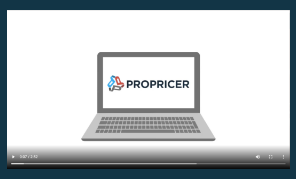Pricing economy matters. It may not always be the highest priority for contracting officers, but if you’re new to the game, you’ll do well to come in relatively low on a contract—at least during your initial bid to an agency.
Setting your price too high is a common defective pricing action that can immediately drop you out of contention for a contract’s shortlist.
And today, the Federal government actually expects a price discount in the pre-award phase. Be realistic. While you don’t want to lose money, you also don’t want to use a contract as a vehicle to try to get wealthy fast. 2
We’ve identified the three top reasons you can inadvertently execute a price fail:
- You haven’t researched similar contracts, resulting in a too-high bid.
Government contracts should be used as ways to create steady, nominal income for your business.
But even if you’re frugal on pricing, maybe a competitor still trumps you in a pre-award situation. One way to prevent a repeat is to use research before bidding to determine past-win pricing on similar contracts. This will help you make sure you’re delivering a competitive offer. 1
Where do you research your prospective client’s past awards? Start on the U.S. General Services Administration (GSA) website, where you can typically find contracts previously awarded by your agency, along with the public-domain financial information that maps to them, including pre-award pricing.
Estimate average hourly labor rates, determine materials costs, and complete contract pricing for your current proposal, based on what your agency has been willing to pay in the past.
On the website, you can also search for similar agencies and their award amounts for like proposals. Here you may not be comparing oranges to oranges, but in this context oranges to tangelos can be close enough.
- You’re not playing by an RFP’s ‘Lowest Price, Technically Acceptable’ rules.
More often than not, agencies now judge proposals submitted for professional and technical services on Lowest Price, Technically Acceptable (LPTA) criteria, rather than on best-value tradeoffs. It’s a strategy shift that’s been in the works for a while now, and it’s finally taken hold.
In typical procurements, the agency involved allows for tradeoffs among cost and non-cost factors—non-cost being things like quality of technical plan, management philosophy, and past performance. But in the case of an LPTA contract, an agency determines—even before the release of the RFP—that there’s no point in weighing tradeoffs. A contractor submitting the lowest bid, who has proven themselves technically sufficient, wins the contract.
Take any other approach, and it’s a defective pricing action.
Under an LPTA evaluation, the client agency judges your proposal categories as either “acceptable” or “unacceptable”—similar to a Pass or Fail system in academia. Net/net: There’s no real point in exceeding any expected value in terms of time and materials.. As long as your technical performance is deemed acceptable throughout the proposal, your lowest price wins.
But remember, the lower you go with your price, the more performance risk both you and your agency assume in a contract.
Some watchouts:
Questionable employee or subcontractor performance. Obviously, the lower salary or contract rate you can pay, the lower your talent level must go. This isn’t to say that exceptional talent can’t be found at a great value. It can. But it takes detective work and stamina to source.
Cost overruns. Keep a close eye on both labor and materials costs, especially in the areas of overtime for the former and late deliveries for the latter. Your profit is already minimal to begin with on an LPTA; you don’t want to end up in the red. 3
- You haven’t differentiated between price reasonableness and price realism.
In both a variable and fixed-price contract situation, you’ll benefit from being able to distinguish between price realism and price reasonableness. Though you’d think they’re the same thing, they’re not. Many contractors have lost awards from the defective pricing action of not learning the distinction.
To an agency, price reasonableness focuses on whether your bid prices are too high, not on whether they’re too low. Price realism involves determining that a contractor’s proposed price is so low that there may be risk of poor grasp of contract terms, or poor performance as a result of hiring unqualified talent or procuring faulty materials.
An agency’s evaluation of your price realism depends upon the terms of the RFP. In many cases, a price realism analysis seeks to determine whether your low price reflects a lack of technical understanding required by the proposal, or whether or not you’re likely to place the contract at risk because of erroneous assumptions around things like scope of work or required skills. It’s an agency’s duty to let all offerors know if they’re conducting a price realism analysis before the analysis begins.
Ideally your price falls somewhere between the lower end of the price reasonableness spectrum, and the upper end of the price realism spectrum.
At times you may have good reason to submit a below-cost bid, such as when you simply want to open a door to an agency or contracting office. It’s a good idea to let your agency client know in your proposal that you fully understand the contract requirements, have every intention of delivering quality product and talent, and are willing to risk profit this one time in order to establish a relationship. 4
To learn more about how agencies determine winning pricing, watch this webinar with Jordan Parks: “The Service Contract Act: Price Adjustment Issues at the DHS.”
Attend the 2022 Government Contract Pricing Summit:
Cultivating Agile Solutions
Gain powerful pre-award pricing insights from industry thought leaders, and network with contractor and agency colleagues from across the nation.
When: June 14-16, 2022
Where: San Diego, CA and online
How: Don’t wait. Get a great rate. Register here.
Sources





